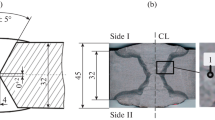Abstract
Residual stress and texture in industrial metal products, processed in different ways, are investigated by means of high-resolution neutron diffraction. The samples are pipe sections made of 30KhN2MFA steel, which are parts of precision machinery and operate under complex loading conditions. The products are manufactured using various methods of plastic deformation, namely, rotary forging and drawing on a mandrel. The results of comparative analysis of the distributions of residual stress and microstrain throughout the wall thickness for all samples are presented. Additionally, neutron texture experiments are performed; based on their results, pole figures are calculated and the crystallographic texture characteristics are evaluated.
Similar content being viewed by others
References
A. J. Allen, M. T. Hutchings, and C. G. Windsor, Adv. Phys. 34, 445 (1985).
I. C. Noyan and J. B. Cohen, Residual Stress—Measurement by Diffraction and Interpretation (Springer, New York, 1987).
H.-J. Bunge, Texture Analysis in Materials Science: Mathematical Methods (Butterworths, London, 1982).
G. D. Bokuchava, V. L. Aksenov, A. M. Balagurov, et al., Appl. Phys. A: Mater. Sci. Process. 74, s86 (2002).
G. D. Bokuchava, A. M. Balagurov, V. V. Sumin, and I. V. Papushkin, J. Surf. Invest.: X-ray, Synchrotron Neutron Tech. 4, 879 (2010).
V. G. Sorokin, A. V. Volosnikova, S. A. Vyatkin, et al., Steels and Alloys: Grade Guide (Mashinostroenie, Moscow, 1989) [in Russian].
H. M. Rietveld, J. Appl. Crystallogr. 2, 65 (1969).
K. Ullemeyer, P. Spalthoff, J. Heinitz, et al., Nucl. Instrum. Methods Phys. Res. A 412, 80 (1998).
L. Lutterotti, S. Matthies, H.-R. Wenk, et al., J. Appl. Phys. 81, 594 (1997).
L. Lutterotti, D. Chateigner, S. Ferrari, and J. Ricote, Thin Solid Films 450, 34 (2004).
Author information
Authors and Affiliations
Corresponding author
Additional information
Original Russian Text © G.D. Bokuchava, R.N. Vasin, I.V. Papushkin, 2015, published in Poverkhnost’. Rentgenovskie, Sinkhrotronnye i Neitronnye Issledovaniya, 2015, No. 5, pp. 3–14.
Rights and permissions
About this article
Cite this article
Bokuchava, G.D., Vasin, R.N. & Papushkin, I.V. Application of neutron stress diffractometry for the study of residual stress and texture in industrial metal products processed in various ways. J. Surf. Investig. 9, 425–435 (2015). https://doi.org/10.1134/S1027451015030039
Received:
Published:
Issue Date:
DOI: https://doi.org/10.1134/S1027451015030039




